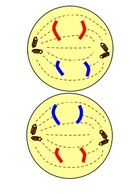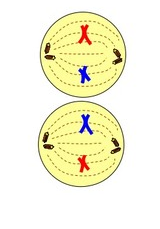HARD
Earn 100
Which among the following image represents the prophase II of meiosis?
(a)

(b)

(c)

(d)

50% studentsanswered this correctly
Important Questions on Cell Cycle and Cell Division
MEDIUM
MEDIUM
EASY
EASY

MEDIUM
MEDIUM
EASY
EASY
MEDIUM
i. Crossing over
ii. Synapsis
iii. Terminalisation of chiasmata
iv. Disappearance of the nucleolus
MEDIUM
| I | II | ||
| () | Synapsis aligns homologous chromosomes | () | Anaphase – II |
| () | Synthesis of RNA and protein | () | Zygotene |
| () | Action of enzyme recombinase | () | – phase |
| () | Centromeres do not separate but chromatids move towards opposite poles | () | Anaphase – I |
| () | Pachytene |
EASY
EASY
MEDIUM
Match the following with respect to meiosis
| (a) | Zygotene | (i) | Terminalization |
| (b) | Pachytene | (ii) | Chiasmata |
| (c) | Diplotene | (iii) | Crossing over |
| (d) | Diakinesis | (iv) | Synapsis |
Select the correct option from the following
EASY
EASY
MEDIUM
Match the changes which occur in the chromosomes during meiosis, with the different phases of prophase-I.
| List - I | List - II | ||
| (a) | Pachytene | (i) | Compaction of chromosomes |
| (b) | Zygotene | (ii) | Terminalisation of chiasmata |
| (c) | Diplotene | (iii) | Pairing of chromosomes |
| (d) | Leptotene | (iv) | Dissolution of synaptonemal complex |
| (v) | Recombination nodule |
The correct answer is
MEDIUM
Arrange the following statements on meiosis in a correct sequence.
A) Terminalisation of chiasmata.
B) Dissolution of synaptonemal complex.
C) Homologous chromosome separation.
D) Appearance of recombination nodules.
E) Pairing of homologous chromosomes.
F) Disappearance of nuclear envelope.
HARD
EASY
MEDIUM
| Column-I | Column–II | ||
| a. | Pachytene | (i) | The pairing of homologous chromosomes |
| b. | Metaphase I | (ii) | Terminalization of chiasmata |
| c. | Diakinesis | (iii) | Crossing-over takes place |
| d. | Zygotene | (iv) | Chromosomes align at the equatorial plate |

